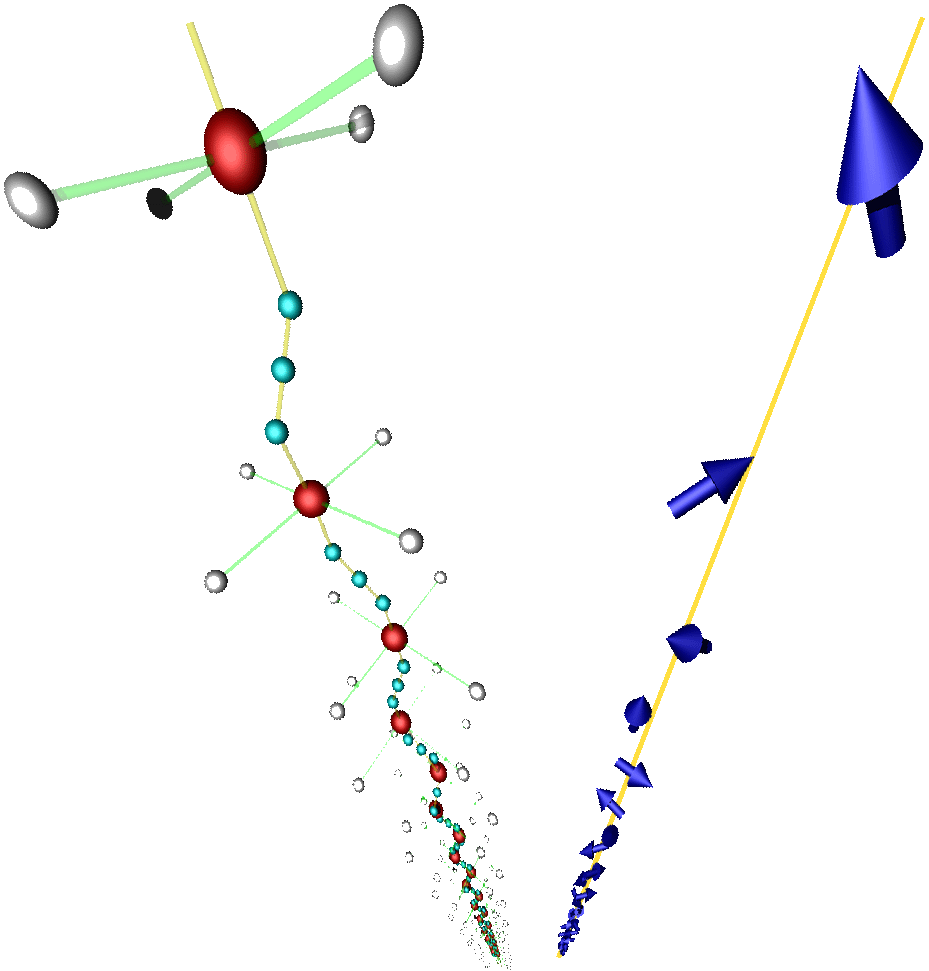
Quantum spin chains
 In one-dimensional (1D) systems, we can investigate anomalous features originating from strong quantum fluctuations in great detail owing to very accurate and reliable numerical and analytical techniques available for 1D systems. In addition, qunatum fluctuatioins in 1D generally tend to become more significant than those in higher dimensions. Thus, we can sometimes extract general features for strongly correlated systems through investigation of 1D systems and sometimes observe interesting features characteristic to 1D systems. Here, I introduce two topics for 1D quantum spin systesms: high-energy states in spin-1/2 quantum spin chains in a magnetic field [1] and quantum criticality of a spin-1 quantum spin chain with bond alternation [2]. The former will be a universal feature of quantum spin systems in a magnetic field, and the latter will be charactereristic to 1D chains.
In one-dimensional (1D) systems, we can investigate anomalous features originating from strong quantum fluctuations in great detail owing to very accurate and reliable numerical and analytical techniques available for 1D systems. In addition, qunatum fluctuatioins in 1D generally tend to become more significant than those in higher dimensions. Thus, we can sometimes extract general features for strongly correlated systems through investigation of 1D systems and sometimes observe interesting features characteristic to 1D systems. Here, I introduce two topics for 1D quantum spin systesms: high-energy states in spin-1/2 quantum spin chains in a magnetic field [1] and quantum criticality of a spin-1 quantum spin chain with bond alternation [2]. The former will be a universal feature of quantum spin systems in a magnetic field, and the latter will be charactereristic to 1D chains.

High-energy excitations of a spin-1/2 Heisenberg chain in a magnetic field [1]

Quantum criticality and comparisons with experiments for a spin-1 chain with bond alternation [2]
[Related papers]
-
"Dynamically Dominant Excitations of String Solutions in the Spin-1/2 Antiferromagnetic Heisenberg Chain in a Magnetic Field",
Masanori Kohno,
Physical Review Letters 102, 037203 (2009).
-
"Low-temperature properties of the spin-1 antiferromagnetic Heisenberg chain with bond alternation",
Masanori Kohno, Minoru Takahashi, and Masayuki Hagiwara,
Physical Review B 57, pp.1046-1051 (1998).
-
"Spectral Properties near the Mott Transition in the One-Dimensional Hubbard Model",
Masanori Kohno,
Physical Review Letters 105, 106402 (2010).
-
"Relation between high-energy quasiparticles of quasi-one-dimensional antiferromagnets in a magnetic field and a doublon of a Hubbard chain",
Masanori Kohno,
Submitted to J. Phys. Conf. Ser.
© 2011 Masanori Kohno
 In one-dimensional (1D) systems, we can investigate anomalous features originating from strong quantum fluctuations in great detail owing to very accurate and reliable numerical and analytical techniques available for 1D systems. In addition, qunatum fluctuatioins in 1D generally tend to become more significant than those in higher dimensions. Thus, we can sometimes extract general features for strongly correlated systems through investigation of 1D systems and sometimes observe interesting features characteristic to 1D systems. Here, I introduce two topics for 1D quantum spin systesms: high-energy states in spin-1/2 quantum spin chains in a magnetic field [1] and quantum criticality of a spin-1 quantum spin chain with bond alternation [2]. The former will be a universal feature of quantum spin systems in a magnetic field, and the latter will be charactereristic to 1D chains.
In one-dimensional (1D) systems, we can investigate anomalous features originating from strong quantum fluctuations in great detail owing to very accurate and reliable numerical and analytical techniques available for 1D systems. In addition, qunatum fluctuatioins in 1D generally tend to become more significant than those in higher dimensions. Thus, we can sometimes extract general features for strongly correlated systems through investigation of 1D systems and sometimes observe interesting features characteristic to 1D systems. Here, I introduce two topics for 1D quantum spin systesms: high-energy states in spin-1/2 quantum spin chains in a magnetic field [1] and quantum criticality of a spin-1 quantum spin chain with bond alternation [2]. The former will be a universal feature of quantum spin systems in a magnetic field, and the latter will be charactereristic to 1D chains.
 High-energy excitations of a spin-1/2 Heisenberg chain in a magnetic field [1]
High-energy excitations of a spin-1/2 Heisenberg chain in a magnetic field [1] Quantum criticality and comparisons with experiments for a spin-1 chain with bond alternation [2]
Quantum criticality and comparisons with experiments for a spin-1 chain with bond alternation [2]